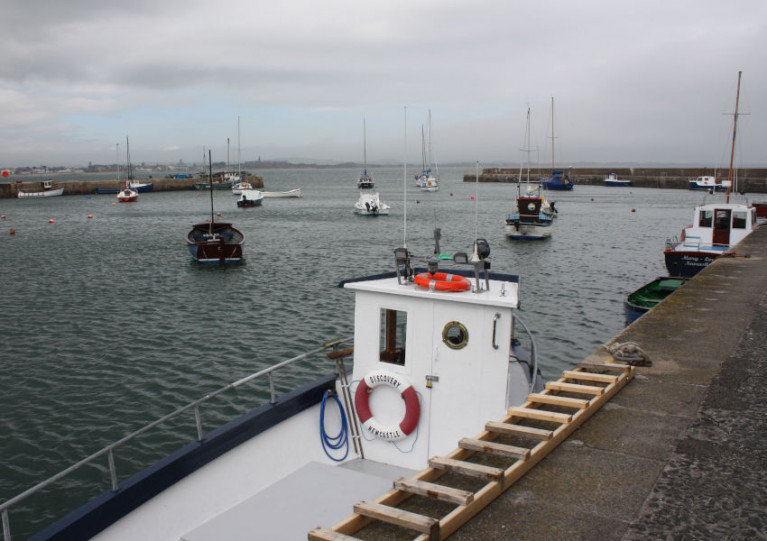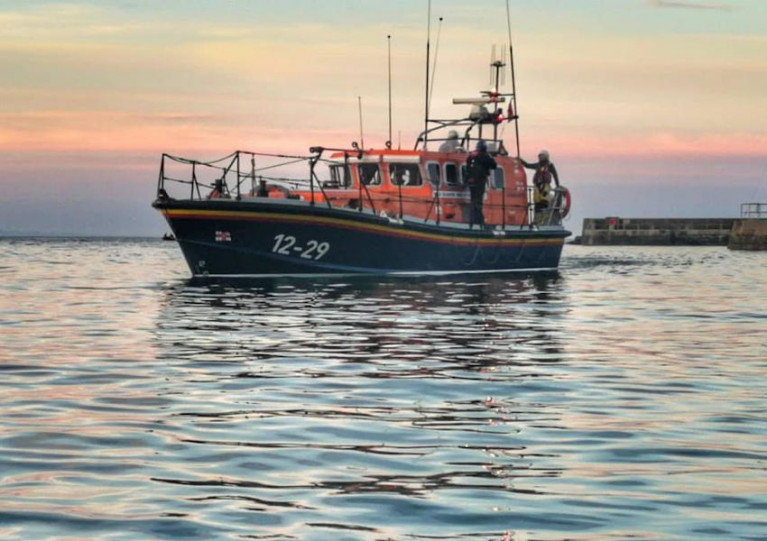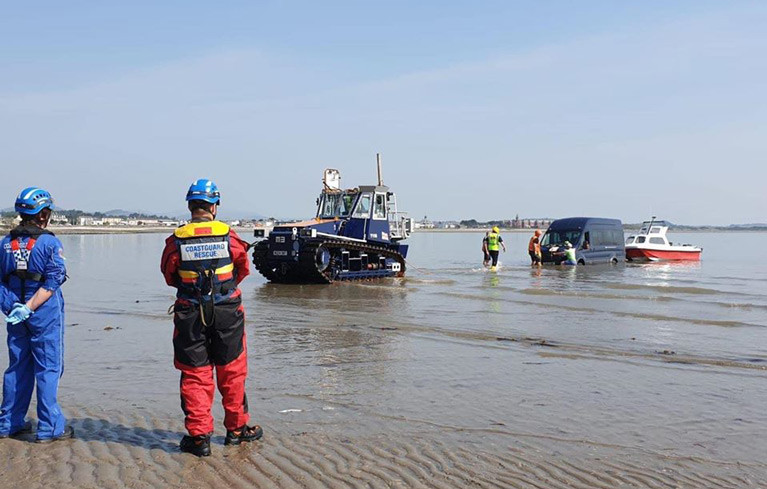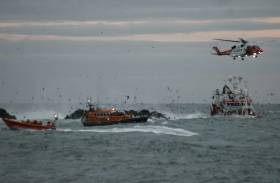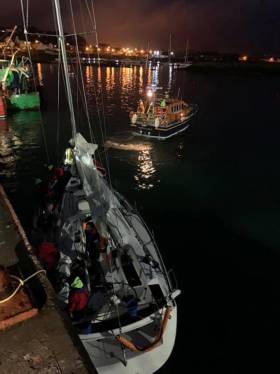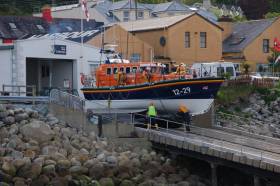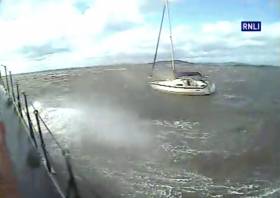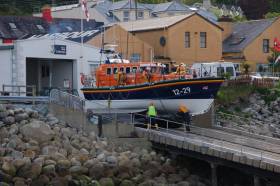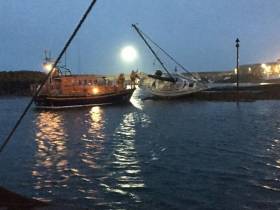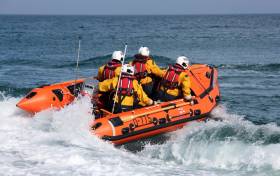Displaying items by tag: Newcastle
Boat Vandals In Co Down Harbour ‘Putting Lives At Risk’
A spate of boat vandalism at Newcastle Harbour in Co Down is putting lives at risk, a former coastguard chief claims.
John Lowry told the Belfast Telegraph that a number of boats in the Northern Ireland harbour have been damaged and loosened from their moorings over recent weeks.
The latest incident saw fellow sailors recover a boat from a nearby beach in difficult weather.
“We’re calling for the council to put more procedures in place,” said Lowry. “Part of the harbour isn't lit up at night at all and the boat owners are calling for help.”
The Belfast Telegraph has more on the story HERE.
The RNLI lifeboat crew in Newcastle, Co Down rescued three people over two callouts in the space of 24 hours earlier this week.
The all-weather lifeboat first launched on Monday morning (13 July) to aid a boat with two people aboard who were experiencing difficulties somewhere between Bloody Bridge and William’s Harbour.
The casualty vessel was located swiftly and was taken under tow to the slipway at Annalong, but tidal conditions required the assistance of the inshore lifeboat to bring it to a safe mooring.
Newcastle RNLI coxswain Nathan Leneghan commended the boat owner for deploying his anchor to prevent the vessel drifting onto rocks, which would have made for a trickier rescue.
The following morning, Tuesday 14 July, the all-weather lifeboat was launched again — this time to a pleasure boat with engine failure.
The lifeboat crew headed in calm conditions to the given location inside the Cow and Calf, some six miles east of station on the East Coast of Northern Ireland.
After navigating through submerged rocks on an ebbing tide, the lifeboat was able to take the casualty vessel, with one person on board, under tow to Dundrum Harbour from where it had set off.
Tidal conditions again necessitated the launch of the inshore lifeboat to assist with the final tow to a safe mooring.
This morning Newcastle RNLI were tasked along with their colleagues from Newcastle and Kilkeel Coastguard to assist a casualty who had trapped his foot under the vehicle with an incoming tide while in the process of trying to launch their boat.
On arrival at the scene, the crew found the casualty had managed to free his foot and Newcastle RNLI tractor assisted the vehicle, which had now become bogged in the soft sand along with boat and trailer back off the shore to safety.
Newcastle NIFRS were also tasked along with PSNI and Belfast CGOC co-ordinated the incident.
Five Crew Rescued From Fishing Boat Aground At Ardglass Harbour
Five crew were rescued from a fishing vessel that ran aground on rocks on approach to Ardglass Harbour early yesterday morning (Wednesday 23 October).
Portaferry and Newcastle RNLI’s volunteer lifeboat crews launched to assist after a Mayday call from the 24-metre vessel, which had been drifting towards Phennick Point outside the harbour.
The Belfast Telegraph reports that the boat, the Cork-registered Dillon Owen, was attempting to enter the harbour to land its herring catch when it quickly lost powe
As the lifeboats proceeded towards Ardglass, the fishing vessel was stuck on the rocks and had begun taking on water. The Dublin-based Irish Coast Guard helicopter Rescue 116 was also scrambled to the scene carrying extra pumps.
Following a dynamic risk assessment between the lifeboats and fishing boat skipper, an attempt was made to tow the vessel off the rocks.
But due to worsening weather and tidal conditions, it was decided after numerous attempts by the Newcastle lifeboat coxswain to evacuate the crew of the vessel instead — with Rescue 116 airlifting them to safety upon its arrival.
Speaking after the rescue, Newcastle RNLI coxswain Nathan Leneghan said: “This morning's rescue was a success due to multi-agency teamwork with our colleagues in the Irish Coast Guard, volunteers at Portaferry RNLI and Portaferry and Newcastle coastguard teams. Thankfully this was positive outcome, and all five fishermen are safe and well.”
Kevin Quigley of the NI Fishery Harbour Authority said the fishing vessel remained listing “very badly” at the harbour and further attempts would be made to refloat it.
Eight French sailors were happy to see Newcastle RNLI when their motor yacht had engine troubles off the Co Down coast last Friday night (19 July).
Conditions were poor, with fog and rain and a southerly Force 3 wind with a 1-2m swell when the all-weather lifeboat reached the stricken boat some 14 miles off Newcastle at 10pm.
All eight on board were found safe and well, and prepared for the rough conditions with foul weather clothing and lifejackets.
At the request of the vessel’s skipper, a tow was established and the boat was towed into Ardglass Harbour, where members of Newcastle Coastguard assisted with mooring.
Speaking afterwards, Newcastle RNLI coxswain Nathan Leneghan said: “We would like to commend the actions of the yacht’s crew for having the correct lifesaving equipment on board and for calling for assistance at the earliest opportunity as the situation could have deteriorated with weather conditions worsening.”
Lifeboats from Clogherhead, Newcastle and Kilkeel were involved in the search for a woman missing in Carlingford Lough at the weekend, which came to a sad end yesterday afternoon (Monday 18 March) with the discovery of a body in the water off Greenore.
Newcastle RNLI was tasked to divert from a morning training exercise on the Co Down coast to join the major search operation which began on Sunday (17 March), concentrating on the entrance to Carlingford Lough and outlying islands.
During this search the all-weather lifeboat located a casualty in the water and, working with volunteer lifeboat crews from Clogherhead and Kilkeel RNLI, the casualty was taken ashore to Greenore Harbour by the Kilkeel lifeboat and placed in the care of An Garda Síochána.
The casualty was shortly after confirmed to be the remains of Ruth Maguire from Newcastle, who went missing during a hen party in Carlingford on Saturday night (16 March).
Speaking following the search, Newcastle RNLI coxswain Nathan Leneghan said: “On behalf of Newcastle RNLI I wish to express our deepest sympathy to the family and friends of the woman who was recovered from the water this afternoon.
“The thoughts and prayers of the everyone involved in the search are with them at this sad time. I also wish to commend the volunteer crews for their commitment and professionalism.”
Kilkeel RNLI lifeboat operations manager John Fisher added: “This was not the outcome we or the family wanted and at this difficult time our thoughts and prayers are with the family and friends of the casualty.
“At this time I would also like to thank the volunteer crew for their commitment and energy. We train for such an incident but always pray that it has a better outcome.”
Three Yachts Rescued In Strangford Lough During Storm Ali
#Rescue - Newcastle RNLI was involved in the rescue of three yachts in Strangford Lough during Storm Ali on Wednesday (19 September).
The lifeboat volunteers were first alerted at 11.40am to go the aid of a stricken yacht at Newtownards Sailing Club in Co Down.
As the all-weather lifeboat launched, under coxswain William Chambers, it quickly became apparent the challenging weather conditions the crew would face on their passage to Newtownards.
The main water tight doors were closed and all crew seated as they faced eight-metre waves hitting from the side.
A Force 8 gale was blowing as the crew approached Strangford Lough. It was some 90 minutes later before the seas started to settle as the lifeboat was sheltered by the shore.
On arrival at Newtownards at 2.15pm, the coastguard was concerned that there may be a person onboard the weather-beaten yacht, Newcastle RNLI confirmed that nobody had been on the boat and she was safely on the mooring.
The lifeboat was then requested to go the aid of another yacht drifting across the lough from White Rock and Kircubbin, but unfortunately by the time the volunteers reached the vessel there was nothing they could do as it was on the rocks on an ebbing tide.
On return to station, approaching Portaferry, the crew were alerted to a third yacht in difficulty. The crew established a tow line and managed to free the vessel and towed it to the safety off a mooring in Strangford.
Leaving the sheltered waters of Strangford Lough, the lifeboat and its crew once again faced mountainous seas and the coxswain decided to stop in Ardglass Marina for an hour to let the wind decrease and the wave size drop.
Leaving Ardglass around 6pm, the crew faced large but bearable seas, making it back to Newcastle an hour later.
“This was a challenging day for our volunteers given that we launched into rough seas when Storm Ali was at its worst,” said Chambers of the seven-hour shout.
“It was also uncertain at that point if there was a life at risk onboard the yacht. Thankfully there wasn’t in this case.
“It was a long and challenging day but our volunteers are highly skilled and trained for these situations and were delighted to be able to help.”
Six Fishermen Rescued By Newcastle Lifeboat In 12-Hour Callout
#RNLI - Newcastle RNLI rescued six fishermen in a callout that lasted 12 hours on Monday 5 February.
At 3.10pm, Newcastle’s volunteer crew were alerted to Belfast Coastguard’s request for a lifeboat to assist a fishing vessel breakdown 15 miles southeast of Newcastle Harbour.
The all-weather Mersey class lifeboat Eleanor and Bryant Girling was launched at 3.20pm and reached the casualty vessel an hour later. Weather conditions at the time were calm but cold with excellent visibility.
Communications were made with the skipper and it was agreed that the best option was for the lifeboat to tow the boat back to the port of Kilkeel.
While the tow got underway at a slow speed of four knots and with 15 miles to go, the estimated time of arrival in Kilkeel was approximately 8.30pm.
However, due to size of the vessel and the tide ebbing, the lifeboat crew were not able to enter the harbour until 1am.
At 12.30am it was decided to launch Kilkeel RNLI’s inshore lifeboat to assist with the manoeuvring of the fishing vessel into the tight harbour entrance. Shortly after 1.20am the vessel was alongside the quay and handed over to Kilkeel Coastguard rescue team.
Speaking following the callout, Newcastle RNLI volunteer lifeboat press officer Nathan Leneghan said: “This was the first callout of the year for Newcastle RNLI and we were delighted to help bring the fishing crew to safety.
“This was a long and challenging callout due to the tide and size of the boat but we worked with the conditions and with the support of colleagues from Kilkeel RNLI were able to bring the boat to safety.
“We would remind anyone taking to sea to always respect the water. Check weather and tide times before you leave and always let someone ashore know when you are leaving and when you are due back. Always wear a lifejacket and always carry a means of calling or signalling for help should you get into difficulty.”
#RNLI - Newcastle RNLI volunteer crews were woken by their pagers at 3.34am yesterday morning (Wednesday 26 July) after a lone yachtsman ran aground at the mouth of Ardglass Marina in Co Down.
The all-weather lifeboat Eleanor and Bryant Girling was on the way by 3.55am and arrived on scene with the casualty vessel 45 minutes later.
The lifeboat crew found the yacht hard aground and listing heavily to starboard on the breakwater protecting the marina.
Under command of coxswain William Chambers, the RNLI crew tried manoeuvring their lifeboat close to the yacht only to find the tide had fallen too much and was too far away to retrieve the lone sailor from his vessel.
With full co-ordination between the RNLI and Newcastle Coastguard on the shore, the lifeboat pulled back to deeper water and provided safety cover while members of the coastguard team carried out a rescue from the shore.
The casualty was removed from the vessel for his own safety with no injuries, and with everyone accounted for the lifeboat was stood down.
#RNLI - Newcastle RNLI was involved in a major air, sea and land search at Tyrella on the Co Down coast last night (Monday 17 July) after walkers reported seeing someone struggling in the sea.
Newcastle RNLI’s inshore lifeboat Eliza and her volunteer crew were tasked along with members of Newcastle Coastguard, local PSNI and their air support helicopter to the area shortly before 9pm last night.
It followed reports from four women who were walking on the beach that there may be a person in difficulty in the water.
A comprehensive search was carried out for almost two hours before the operation was stood down with nothing found.
Newcastle RNLI volunteer lifeboat helm Nathan Leneghan said: “Conditions were ideal for searching with very few waves and just the right amount of sunlight.
“We know Tyrella is a very popular beach and with the favourable weather at the moment we advise people to always try to swim at lifeguarded beaches and respect the water.
“We would rather be called out for a genuine false alarm than be called out too late. These women took the right action and should be commended.”
Newcastle RNLI advises the public that if they see someone in trouble on or near the water to dial 999 or 112 immediately and ask for the coastguard.


























